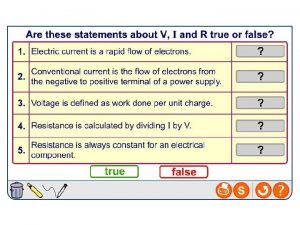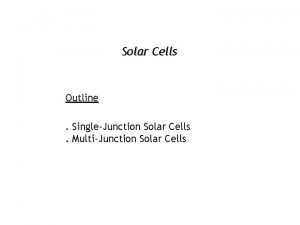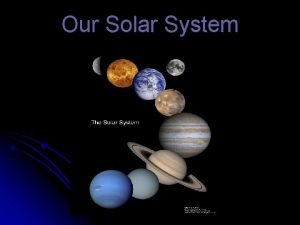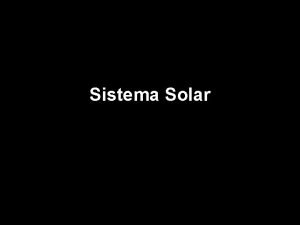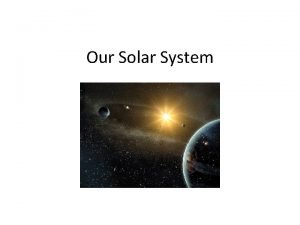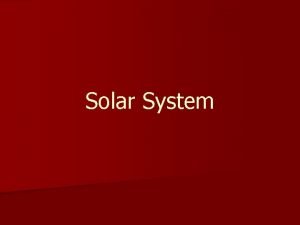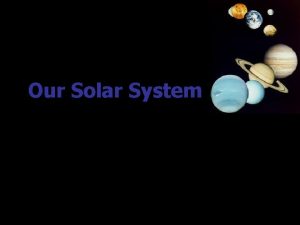Solar Day Recall that the solar day is










































- Slides: 42

Solar Day Recall that the solar day is the result of a "competition" between Earth’s rotation and its revolution around the Sun i. e. 361 degrees from noon to noon However, Earth’s rotation rate is virtually constant, the rate at which the Sun traverses the celestial sphere as it moves along the ecliptic, is not, because:

Solar Day First, Earth’s orbit is not exactly circular and our orbital speed is not constant so the speed at which the Sun moves along the ecliptic varies with time.

Solar Day Second, in normal terms: Equinox – sun is moving at an angle to equator appears slower Solstice – sun moves parallel with equator appears faster

Sun Path The day arc of the Sun, every hour, during the equinoxes as seen on the celestial dome, from the equator. Also showing 'twilight suns' down to -18° altitude. Note the Sun in the zenith at noon and no shadows.

Sun Path Equinox at the equator the sun appears for more hours than any other days at the equator. Direct overhead is the sun’s longest path.

Sun Path The day arc of the Sun, every hour, during the equinoxes as seen on the celestial dome, from 50° latitude

Sun Path Because of the axial tilt The sun will have different arc-paths, and solar time is not the same at all places.

Solar Day The combination of these effects means that the solar day varies by roughly half a minute over the course of the year The solution is to define a mean solar day, originally cast in terms of a fictitious mean Sun that moves around the celestial equator at constant speed but which in effect is just the average solar day over an entire year. This is the day our clocks (atomic or otherwise) measure, and it is by definition constant. One second is 1/24 1/60 = 1/86, 400 mean solar days.

Seasons Diagram of the Earth's seasons as seen from the north. Far right: December solstice

Seasons Diagram of the Earth's seasons as seen from the south. Far left: June solstice

seasons. mov

Long-term changes We have seen how these motions can account for the changing night sky and the changing seasons. Like a spinning top that rotates rapidly on its own axis while that axis slowly revolves about the vertical, Earth’s axis changes its direction over the course of time (although the angle between the axis and a line perpendicular to the plane of the ecliptic always remains close to 23. 5°)

Long-term Chanes Continuing with the spinning top. . . Looking at the axis from the top down: We see the circle the north pole traces out over time. In AD 16000 the North Star will not be Polaris, it will be Vega

Long-term Changes precession The slow change in the direction of the axis of a spinning object, caused by some external influence. It is caused by torques (twisting forces) on Earth due to the gravitational pulls of the Moon and the Sun, which affect our planet in much the same way as the torque due to Earth’s own gravity affects the top

Year Definitions tropical year The time interval between one vernal equinox and the next. sidereal year The time required for the constellations to complete once cycle around the sky and return to their starting points, as seen from a given point on Earth.

Moon The Moon's appearance undergoes a regular cycle of changes, or phases, taking a little more than 29 days to complete. (The word month is derived from the word moon. )

Moon Because the Moon orbits Earth, the visible fraction of the sunlit face differs from night to night. The complete cycle of lunar phases takes 29. 5 days to complete.

Moon The Moon doesn’t actually change its size and shape from night to night. Its full circular disk is present at all times. Why don’t we always see a full Moon?

Moon Because. . . unlike the Sun and the other stars, the Moon emits no light of its own. Instead, it shines by reflected sunlight.

Moon • Sidereal Month The difference between a synodic and a sidereal month comes from the motion of Earth relative to the Sun. • Synodic month = 29. 5 • Sidereal month = 27. 3 • The moon moves 360° in one sidereal month, however it does not line up with the moon. • 2. 2 days later the moon lines up with the sun for a New Moon • 2. 2 days means a couple more degrees that the moon revolves around

Moon Starting from the new Moon, which is all but invisible in the sky. . .

Moon the Moon appears to wax (or grow) a little each night and is visible as a growing crescent. Note: Which direction is the sun shining from? Waxing crescent (4 days)

Moon One week after new Moon, half of the lunar disk can be seen. This phase is known as a quarter Moon. Quarter Moon (7 days)

Moon During the next week, the Moon continues to wax, passing through the gibbous phase. Gibbous phase (10 days)

Moon Two weeks after new Moon, the full Moon is visible. Full Moon (14 days)

Moon During the next two weeks, the Moon wanes (or shrinks). Waning Gibbous (18 days)

Moon passing through the waning quarter. Waning Third Quarter (22 days)

Moon and the waning crescent. Waning Crescent (24 days)

Moon eclipse Event during which one body passes in front of another, so that the light from the occulted body is blocked.

Moon lunar eclipse Celestial event during which the Moon passes through the shadow of the Earth, temporarily darkening its surface. partial eclipse Celestial event during which only a part of the occulted body is blocked from view total eclipse Celestial event during which one body is completely blocked from view by another

Moon Lunar Eclipse A lunar eclipse occurs when the Moon passes through Earth’s shadow. We see a darkened, copper-colored Moon, as shown in the inset photograph. The red coloration is caused by sunlight being reddened and deflected by Earth’s atmosphere onto the Moon’s surface. An observer on the Moon would see Earth surrounded by a bright but narrow ring of orange sunlight.

Solar Eclipse When the Moon and the Sun are in exactly the same direction, as seen from Earth, an even more awe-inspiring event occurs. The Moon passes directly in front of the Sun, briefly turning day into night in a solar eclipse. In a total solar eclipse, when the alignment is perfect, planets and some stars become visible in the daytime as the Sun’s light is reduced to nearly nothing. We can also see the Sun’s outer atmosphere, or corona total eclipse Celestial event during which one body is completely blocked from view by another

Solar Eclipse Unlike a lunar eclipse, which is simultaneously visible from all locations on Earth’s night side, a total solar eclipse can be seen from only a small portion of Earth’s daytime side. The Moon’s shadow on Earth’s surface is about 7000 kilometers wide—roughly twice the diameter of the Moon (Figure 1. 19). Outside of that shadow, no eclipse is seen.

Solar Eclipse umbra Central region of the shadow cast by an eclipsing body. The central region of a sunspot, which is its darkest and coolest part. penumbra Portion of the shadow cast by an eclipsing object in which the eclipse is seen as partial.

Solar Eclipse

Solar Eclipse Why isn’t there a solar eclipse at every new Moon and a lunar eclipse at every full Moon? The answer is that the Moon’s orbit is slightly inclined to the ecliptic (5. 2°), so the chance that a new (or full) Moon will occur just as the Moon happens to cross the ecliptic plane (so Earth, Moon, and Sun are perfectly aligned) is low.

Solar Eclipse The two points on the Moon’s orbit where it crosses the ecliptic plane are known as the nodes of the orbit

Solar Eclipse For an eclipse to occur, the line of intersection of the two planes must lie along the Earth–Sun line. Thus, eclipses can occur only at specific times of the year. Only the umbra of each shadow is shown, for clarity

Solar Eclipse • Regions of Earth that will see total or annular solar eclipses between the years 2000 and 2020. • Each track represents the path of the Moon’s umbra across Earth’s surface during an eclipse.

Solar Eclipse • The width of the track depends upon latitude on Earth and upon the distance from Earth to the Moon during the eclipse. High-latitude tracks are broader because sunlight strikes Earth’s surface at an oblique angle near the poles (and also because of the projection of the map). • The closer the Moon is to Earth during a total eclipse, the wider the umbra

Eclipse Year The gravitational tug of the Sun causes the Moon's orbital orientation, and hence the direction of the line of nodes, to change slowly with time. As a result, the time interval between one orbital configuration with the line of nodes pointing at the Sun and the next (with the Moon crossing the ecliptic in the same sense in each case) is not exactly 1 year, but instead is 346. 6 days—one eclipse year.

Eclipse Year Thus the eclipse seasons gradually progress backward through the calendar, occurring about 19 days earlier each year. This phenomenon is known as the regression of the line of nodes. • 1991 the eclipse seasons were in January and July; on July 11 a total eclipse actually occurred, visible in Hawaii, Mexico, and parts of Central and South America. • 1994, the eclipse seasons were in May and October; on May 10 an annular eclipse was visible across much of the continental United States. • 1999, the eclipse seasons had drifted into February and August, and on August 11 much of Europe and southern Asia was treated to the last total eclipse of the millennium.
 Day 1 day 2 day 3 day 4
Day 1 day 2 day 3 day 4 Block nhĩ thất độ 1
Block nhĩ thất độ 1 Tìm vết của đường thẳng
Tìm vết của đường thẳng Sau thất bại ở hồ điển triệt
Sau thất bại ở hồ điển triệt Thơ thất ngôn tứ tuyệt đường luật
Thơ thất ngôn tứ tuyệt đường luật Con hãy đưa tay khi thấy người vấp ngã
Con hãy đưa tay khi thấy người vấp ngã Thơ thất ngôn tứ tuyệt đường luật
Thơ thất ngôn tứ tuyệt đường luật Tôn thất thuyết là ai
Tôn thất thuyết là ai Phân độ lown
Phân độ lown Walmart thất bại ở nhật
Walmart thất bại ở nhật Gây tê cơ vuông thắt lưng
Gây tê cơ vuông thắt lưng Day 1 day 2 day 817
Day 1 day 2 day 817 Solar energy is free. solar is inexhaustible
Solar energy is free. solar is inexhaustible Solar panels wholesale
Solar panels wholesale Trời xanh đây là của chúng ta thể thơ
Trời xanh đây là của chúng ta thể thơ Voi kéo gỗ như thế nào
Voi kéo gỗ như thế nào ưu thế lai là gì
ưu thế lai là gì Thẻ vin
Thẻ vin Các châu lục và đại dương trên thế giới
Các châu lục và đại dương trên thế giới Cái miệng bé xinh thế chỉ nói điều hay thôi
Cái miệng bé xinh thế chỉ nói điều hay thôi Thế nào là hệ số cao nhất
Thế nào là hệ số cao nhất Frameset trong html5
Frameset trong html5 Từ ngữ thể hiện lòng nhân hậu
Từ ngữ thể hiện lòng nhân hậu Diễn thế sinh thái là
Diễn thế sinh thái là Tư thế ngồi viết
Tư thế ngồi viết Ví dụ về giọng cùng tên
Ví dụ về giọng cùng tên Mật thư anh em như thể tay chân
Mật thư anh em như thể tay chân Glasgow thang điểm
Glasgow thang điểm Hổ đẻ mỗi lứa mấy con
Hổ đẻ mỗi lứa mấy con Hát kết hợp bộ gõ cơ thể
Hát kết hợp bộ gõ cơ thể đại từ thay thế
đại từ thay thế Vẽ hình chiếu vuông góc của vật thể sau
Vẽ hình chiếu vuông góc của vật thể sau Các châu lục và đại dương trên thế giới
Các châu lục và đại dương trên thế giới Bổ thể
Bổ thể Thế nào là mạng điện lắp đặt kiểu nổi
Thế nào là mạng điện lắp đặt kiểu nổi Dạng đột biến một nhiễm là
Dạng đột biến một nhiễm là Lời thề hippocrates
Lời thề hippocrates Vẽ hình chiếu đứng bằng cạnh của vật thể
Vẽ hình chiếu đứng bằng cạnh của vật thể Quá trình desamine hóa có thể tạo ra
Quá trình desamine hóa có thể tạo ra Làm thế nào để 102-1=99
Làm thế nào để 102-1=99 Alleluia hat len nguoi oi
Alleluia hat len nguoi oi Sự nuôi và dạy con của hổ
Sự nuôi và dạy con của hổ điện thế nghỉ
điện thế nghỉ



















































